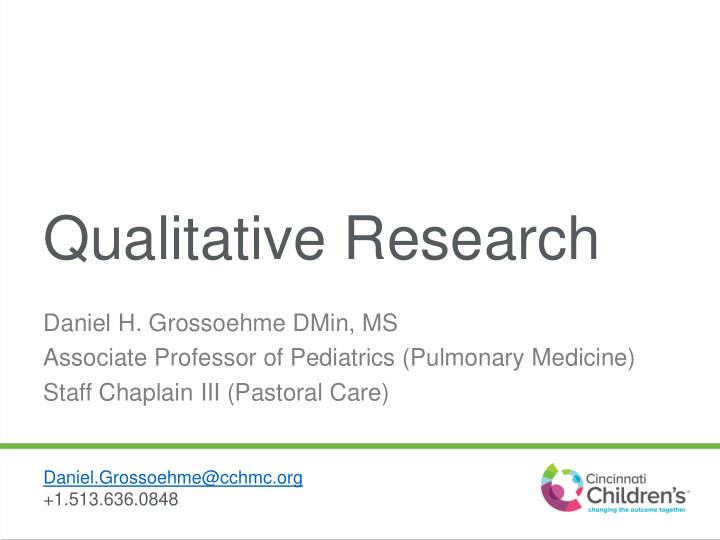



Qualitative Research Daniel H. Grossoehme DMin, MS Associate Professor of Pediatrics (Pulmonary Medicine) Staff Chaplain III (Pastoral Care) Daniel.Grossoehme@cchmc.org +1.513.636.0848
Introduction • “the systematic collection, organization and interpretation of textual material derived from talk or conversation…used in the exploration of meanings of social phenomena as experienced by individuals themselves, in their natural context.” • (Malterud, 2001, p. 483)
“…derived from talk or conversation…”
Introduction: “Why?”, not “How?” • Not all RQs can be answered numerically • Questionnaires presume a theoretical base – What if there is not one? – What if you do not agree with that theory? • Qualitative methods are only means of – Developing some data – Hearing some incredibly sacred stories • Mixed methods are even more powerful: 2+2>4
Introduction • Advantages: – Usually does not require significant budget – Small sample sizes (typically N=16-24) – Avoids argument, “But you can’t measure God!” – Develops new knowledge • Deep questions bring tacit knowledge to awareness • Get in touch with something they didn’t know they had • Leads to greater connection with the self in new ways – Asking a question is a chaplaincy intervention – Consistent with chaplaincy practice
Introduction: Consistent with chaplaincy practice • Help patients/families tell narratives • Intense listening to the other’s narrative • Use of open-ended questions to add depth • This is what we do!
Introduction: words of caution • Time-intensive • Qualitative studies lacked rigor – Validity – Reliability – Sample size • Post-modern epistemology – I know what I know because you told me – Knowledge (truth) is socially constructed – Reflexivity: we influence the narrative • Role clarity: researcher or caregiver?
Data collection • Sample size – More ≠ better – Might be as few as 8! – More likely 16-24 – “Saturation” • Not, not, not “when you don’t hear anything new” • When your categories or themes are fully saturated: you completely understand the theme (Hennink, M.M., Kaiser, B.N. and Marconi, V.C., 2017. Code saturation versus meaning saturation: How many interviews are enough?. Qualitative health research, 27(4), pp.591-608.)
Data collection: sampling • Random sampling • You want the outliers! – People with in-depth, specialized knowledge – Not a “representative” sample • Purposive sampling • Theoretical sampling
“Oh, you just go out and talk to people…”
Analytic frameworks: 1. Grounded theory 2. Phenomenology 3. Ethnography
Grounded Theory • Develops a theory to understand a (psycho)social process – “How do spiritual beliefs of parents of children diagnosed with cystic fibrosis relate to their completing their child’s daily home therapies?” • When there is no existing theory • Theory is “grounded” in participants’ words • Hypothesis-generating, not hypothesis-testing
Grounded Theory • Identifying and categorizing segments of data in participant’s words that describe the process of interest
Phenomenology • What is the lived experience? • “What is it like to….?” • Analysis – Express the spiritual/religious (psychological?) insight contained in them – Synthesize these into a consistent statement of experience • Kociszewski: “What is it like for nurses to provide spiritual care for patients and families?”
Ethnography • Support the design of a new process • Deep understanding of the problem • Enable a better design solution • Suppose….improve outcomes for adolescents with Crohn’s Disease • Multiple modes of data collection – Observation and field notes – Interviews – Documents
Longitudinal qualitative studies • Understand a topic over time • How stable are parental spiritual beliefs as they relate to a child’s cystic fibrosis? • Are spiritual beliefs modifiable? – If yes, then chaplain may invite alternatives – If no, then chaplain may provide supportive care
Ethical issues • Risk management strategies – Self-injurious disclosures – Emotional distress induced by interview – What do you do with data like this? • P: I did her last breathing treatment and then put her to bed, and that took about 45 minutes. • I: And then what did you do? • P: Drank a bottle of wine • I: How long did that take? • P: About 20 minutes
Ethical issues • Bereaved persons – Can they consent? – Are the “too vulnerable” or is it healing? – How long before interview?
Ethical issues • Privacy & confidentiality: quotations • Safety – Chaperones – Protect your coders & transcriptionists • Suicide notes • Chapel prayers • Palliative care families
A few words from an Editor… • Qualitative work justly criticized for sloppiness • Studies need to have reliability & validity • Studies need to be clearly written • Case studies should describe spiritual history, intervention(s) and impact they made • Follow the Author Guidelines!
Questions? Daniel.Grossoehme@cchmc.org 1.513.636.0848
Recommend
More recommend